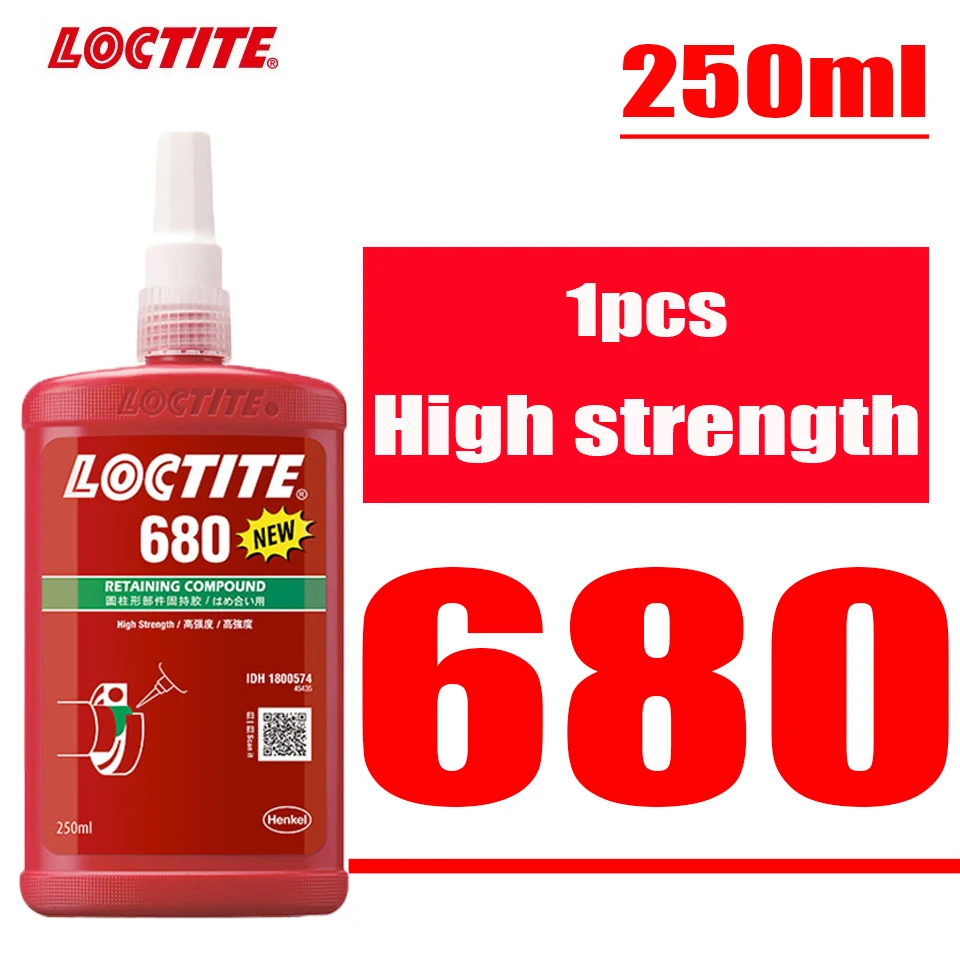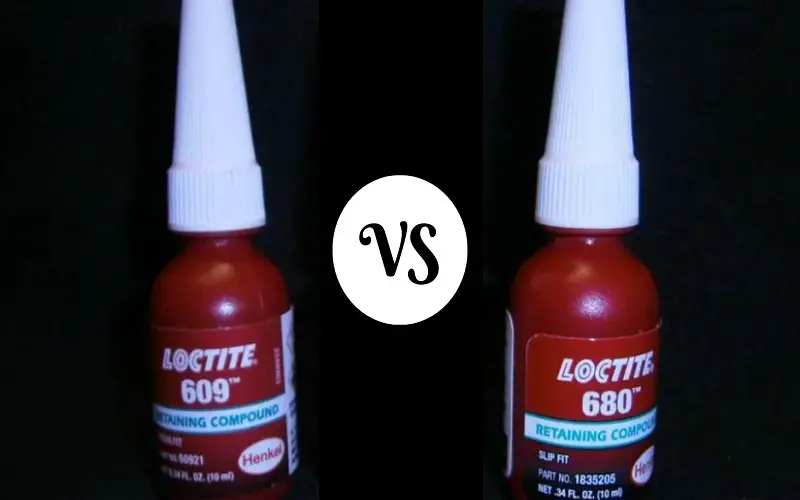Loctite 609 is a high-strength, high-temperature retaining compound, while Loctite 680 is a high-strength, high-temperature retaining compound with a faster fixture time. These adhesives are widely used in industrial applications for bonding cylindrical parts, but their key differences lie in their curing time and strength capabilities.
When it comes to industrial bonding solutions, choosing the right retaining compound can significantly impact the efficiency and durability of the assembly.
Loctite 609 and 680 are both top contenders in this category, offering high-strength bonding for cylindrical parts. Understanding the differences between these two products can aid in making an informed decision for specific application needs.
We will compare the key features of Loctite 609 and 680, shedding light on their respective strengths and curing times to assist in selecting the most suitable option for industrial bonding purposes.

Contents
Loctite 609 Vs Loctite 680
Application
When it comes to choosing the right adhesive for your specific application, it’s important to understand the differences between Loctite 609 and Loctite 680.
Each product has its own set of suitable applications, based on its unique properties and capabilities.
Suitable Applications For Loctite 609
Loctite 609 is a high-strength, rapid-curing adhesive that is designed for bonding cylindrical fitting parts. It is particularly suitable for applications where small diametrical gaps need to be filled.
Some suitable applications for Loctite 609 include:
- Bonding of cylindrical assemblies such as sleeves, bushes, and bearings
- Securing of small, cylindrical parts like rotor shafts and set screws
- Fixing press-fit components and keyless shaft/hub connections
Suitable Applications For Loctite 680
Loctite 680 is a high-strength, high-viscosity adhesive that is specifically formulated for bonding cylindrical parts. It is designed to provide excellent gap-filling properties and is ideal for applications where uniform stress distribution is required.
Some suitable applications for Loctite 680 include:
- Bonding of cylindrical parts with larger diametrical clearances
- Repairing worn parts in machinery and equipment
- Securing cylindrical assemblies in heavy-duty applications

Key Characteristics
Curing Time
The Curing time of Loctite 609 is quick, within minutes, whereas Loctite 680 requires longer curing time.
Strength And Resilience
Loctite 680 offers higher strength and resilience compared to Loctite 609, making it more durable.
Performance
Loctite 609 and 680 offer high-performance bonding solutions for different applications. While Loctite 609 is ideal for cylindrical assemblies, Loctite 680 is more versatile, suitable for gaps up to 0. 2mm. Each product excels in providing durable and reliable bonding strength.
When it comes to choosing the right adhesive for your project, Loctite offers a range of options that can cater to your specific needs. Two popular options, Loctite 609 and Loctite 680, are known for their exceptional performance in various environments and their impact on bonded materials.
In this article, we will delve into the comparative performance of Loctite 609 vs 680, examining how they perform in different environments and the effects they have on bonded materials.
Comparative Performance In Different Environments
Loctite 609 and Loctite 680 are designed to excel in different environmental conditions, making them suitable for a wide range of applications.
| Loctite 609 | Loctite 680 |
|---|---|
| Perfect for use in temperature ranges of -55°C to +150°C | Ideal for applications requiring resistance to high temperatures up to +230°C |
| Provides excellent chemical resistance, making it a reliable choice for applications exposed to oils, fuels, and solvents. | Offers exceptional resistance to chemicals, including fuels, oils, and hydraulic fluids. |
| Works well in environments where vibrations and impacts are a concern, ensuring durable and long-lasting bonds. | Excels in situations where dynamic loadings, such as heavy machinery and constant vibrations, are present. |
As shown in the table above, Loctite 609 and Loctite 680 have specific strengths in different environmental conditions.
Therefore, it is crucial to consider the temperature range, chemical exposure, and presence of vibrations or impacts when selecting the appropriate adhesive for your project.
Impact On Bonded Materials
Both Loctite 609 and Loctite 680 are formulated to bond a variety of materials effectively. However, they exhibit slight differences in their impact on certain materials.
- Loctite 609: This adhesive is particularly suited for bonding cylindrical fitting parts, such as bearings, bushes, and cylindrical assemblies. Its high viscosity ensures excellent gap-filling properties, making it an ideal choice for parts with larger gaps.
- Loctite 680: This adhesive is specifically formulated for bonding cylindrical parts that have a tight fit, without any gaps. Its low viscosity enables it to penetrate tight clearances, ensuring maximum contact and bond area.
Whether you need to fill gaps or bond materials with precise fits, understanding the impact of Loctite 609 and Loctite 680 on different materials helps you make an informed decision.
Compatibility
When it comes to choosing the right adhesive for your specific needs, compatibility is an essential factor to consider.
The compatibility of an adhesive refers to its ability to bond effectively with different types of materials. In this section, we will explore the material compatibility of two popular Loctite products: Loctite 609 and Loctite 680.
Material Compatibility For Loctite 609
Loctite 609 is a high-strength retainer adhesive that is commonly used for bonding cylindrical fitting parts.
This adhesive is specifically designed to provide a secure and durable bond in applications where a tight press-fit or interference fit is required.
When it comes to material compatibility, Loctite 609 is compatible with a wide range of materials, including:
- Metal
- Plastics
- Composite materials
- Ceramics
- Concretes
Whether you are working on automotive repairs, industrial manufacturing, or even DIY projects, Loctite 609 offers great versatility in terms of its material compatibility.
It ensures a strong bond that can withstand high temperatures, vibrations, and even chemical exposure.
Material Compatibility For Loctite 680
Loctite 680 is an adhesive that is specifically formulated for bonding cylindrical assembled parts. This medium-strength adhesive is known for its exceptional bond strength and resistance to impact and thermal cycling.
When it comes to material compatibility, Loctite 680 is suitable for bonding various types of materials, including:
- Metals
- Plastics
- Composites
- Rubbers
- Leathers
Whether you need to secure bearings, bushings, or other assembled parts, Loctite 680 provides a reliable bond on a wide range of materials.
Its ability to bond different types of materials makes it an excellent choice for applications in industries such as aerospace, marine, and manufacturing.
Choosing the right adhesive with the appropriate material compatibility is crucial for achieving long-lasting and effective bonding results. Both Loctite 609 and Loctite 680 offer compatibility with various materials, allowing you to use them in diverse applications.
Evaluate the requirements of your specific project, select the appropriate adhesive, and enjoy the benefits of a strong and reliable bond.
Cost And Availability
When comparing Loctite 609 and 680, evaluating the cost and availability is crucial. Let’s delve into the details:
Comparison Of Cost
Loctite 609: Generally, Loctite 609 is more affordable than 680, making it a budget-friendly option.
Loctite 680: While slightly pricier than 609, the performance of 680 justifies its higher cost.
Availability In Different Markets
| Market | Loctite 609 | Loctite 680 |
|---|---|---|
| North America | Widely available | Readily accessible |
| Europe | Commonly stocked | Easy to find |
| Asia | Increasing availability | Growing presence |
- Loctite 609: Available in various online and brick-and-mortar stores globally.
- Loctite 680: Found in specialized stores and industrial suppliers.
- Consider your project requirements when choosing between Loctite 609 and 680.
- Check local suppliers or online platforms for the best deals on these products.
User Experience
When it comes to user experience, the choice between Loctite 609 and 680 can significantly impact ease of use and long-term reliability for various applications. Let’s delve into user feedback regarding these aspects.
Feedback On Ease Of Use
Users consistently praise the ease of application with Loctite 609, especially in scenarios requiring precise bonding with minimal mess. The low-viscosity formula of 609 is lauded for facilitating smooth dispensing and efficient coverage on intricate surfaces.
Additionally, the rapid curing capability of 609 often garners positive feedback, enabling users to proceed with subsequent assembly steps promptly.
Long-term Reliability
When it comes to long-term reliability, users emphasize the exceptional performance of Loctite 680. Its high-temperature resistance and excellent resistance to vibration make it a favored choice for applications prone to extreme conditions.
Feedback indicates that assemblies bonded with 680 exhibit sustained strength and durability over extended periods, instilling confidence in its reliability for critical components.
Frequently Asked Questions Of Loctite 609 Vs 680
What Is Loctite 609 Used For?
Loctite 609 is used as a high-strength retainer adhesive. It is ideal for bonding cylindrical fitting parts and filling gaps between them. This adhesive provides excellent resistance to low temperatures, chemicals, and liquids.
Is Loctite 609 Permanent?
No, Loctite 609 is not permanent as it is a removable adhesive.
How Strong Is Loctite 609?
Loctite 609 is a high-strength, fast-curing adhesive. It provides strong bonds for press and slip-fitted parts, offering reliable performance.
Can Loctite 680 Be Removed?
Yes, LOCTITE 680 can be removed using heat and hand tools.
Conclusion
In the comparison between Loctite 609 and 680, each serves specific bonding needs efficiently. Understanding their differences is crucial for successful application in various industries.
Whether fast curing or high strength is a priority, both adhesives offer reliable solutions for bonding applications. Choose wisely based on project requirements

